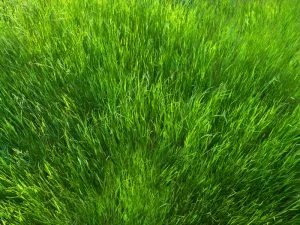Not all grasses are created equal. Out of all of the different grass species that exist, only a handful may be suitable for a particular region. And each type requires different care to make your yard look its best. Some of the grass types recommended for use in Northern Ohio include Kentucky bluegrass, perennial ryegrass, bentgrass, tall fescue, and fine fescue, but Kentucky bluegrass is the most popular for its hardy traits and attractive appearance.
Benefits of Kentucky Bluegrass
Known for its color, density, and fine texture, Kentucky bluegrass is well-suited to Ohio’s soil and climate. Capable of withstanding extreme temperatures, it is winter hardy, resistant to some grass diseases, able to recover quickly from damage, and has a long life when cared for properly. This high-quality grass species produces underground stems, called rhizomes, which help it spread and heal itself quickly.
Kentucky bluegrass also requires proper maintenance. Some varieties require regular fertilizers and irrigation to keep a lush appearance, while others don’t do well in deep shade. Often, several bluegrass seed varieties are mixed together to create a stronger blend that’s able to address these issues.
Lawn Care Tips for Kentucky Bluegrass
- Mowing – Kentucky bluegrass is best when its mowing height is kept somewhere between 2 and 2-1/2 inches. This helps the grass retain moisture and keep a dense base. Make sure mower blades are kept sharp for a clean cut, and never cut off more than 1/3 of a grass blade during each mowing.
- Feeding/Fertilization – Fertilizer provides soil with supplemental nutrients like nitrogen, phosphorus, and potassium to help your lawn thrive. However, improper fertilizing can cause problems like iron chlorosis, which occurs when there is a higher level of phosphorus mixed into the fertilizer than the bluegrass needs. Feeding a bluegrass lawn requires approximately 3 to 6 lbs of nitrogen per 1,000 square feet annually. This should be divided into 3 or 4 applications a year, depending on the level of maintenance your lawn requires.
- Watering – Kentucky bluegrass is not a drought-tolerant grass and can become dormant during extremely dry periods. Fortunately, it is very resilient and often recovers without damage. In order to maintain its lush, green appearance, the grass should be watered two times a week during the summer months if there is no rain.
- Keep it healthy –The best defense against any lawn disease, weeds, and harmful insects is proper maintenance. Kentucky bluegrass can fall prey to lawn diseases such as powdery mildew, snow mold, brown patch, fairy ring, and red thread. When this type of grass is properly cared for, it tends to grow dense enough to keep weeds from invading.
- Better blending – Many lawn-care issues can be avoided by using a mix of Kentucky bluegrass seed varieties. There are many blends available, each one created to solve particular challenges, like shade and drought intolerance. If you are unsure which blend is best for your lawn, ask a professional.
Selecting the proper type of grass is crucial when establishing your lawn—after all, it is the foundation of your landscaping. Call Free Spray Lawn Care today at 419-529-5296 to consult with professionals who can help keep your lawn healthy and well maintained.



Comments (0)
Thanks for your comment!
Thanks for your feedback! Your comments have been successfully submitted! Please note, all comments require admin approval prior to display.
Error submitting comment!
There is a problem with your comment, please see below and try again.